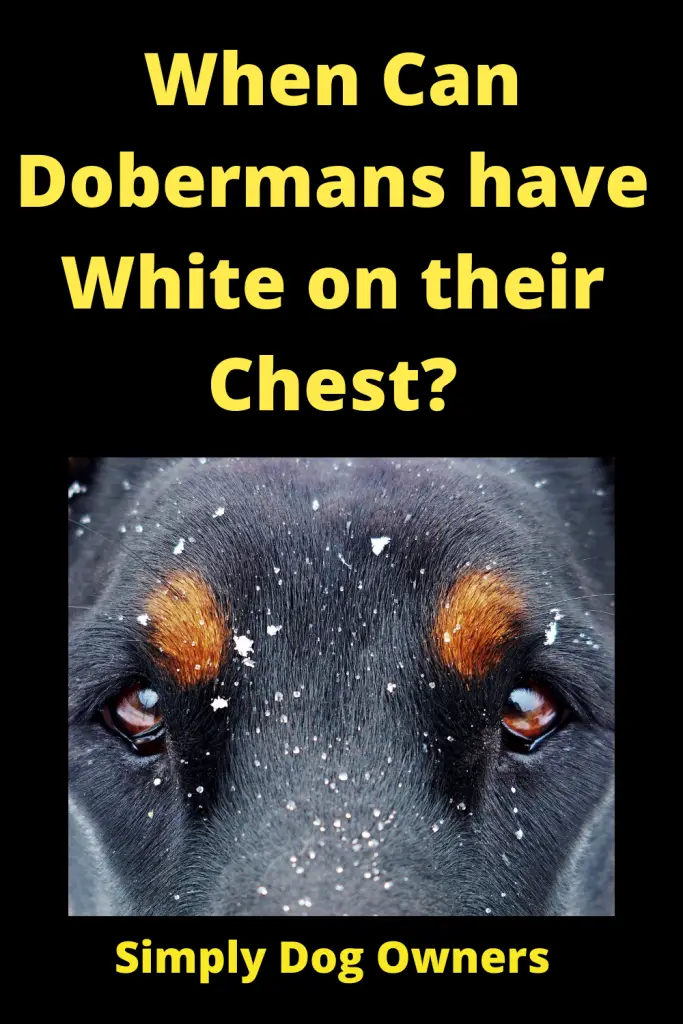When can Dobermans have White on their Chest?
When can Dobermans have white on their chest? The Dobermans have frequent white color marking on their chest when they born. It’s due to their genetics. Some Dobermans have developed this when they become adults. It’s a natural phenomenon. The markings appear on each eye, on the muzzle, chest, throat, below the tail, and on all legs and feet on rusted Dobermans. A small white patch can be found on the chest of certain Dobermans.
Do Dobermans have White on Their Chest?
Yes, they have, since the white element is a color masking gene with a binary value (it’s either present or it’s not – everything or nothing).
It’s most likely descended from the white at some point in the pedigree. They may have up to 1/8 inch of white on their chest, but any more than that is a DQ for this breed, and they will never be seen… That’s what turns an otherwise good dog into a pet.

Why do Dogs have a White Spot on their Chest?
When the pigment does not migrate entirely as the embryo grows, a small amount of white may appear on the chest, toes, or tail. This is known as residual white, and a slight infection can cause it in the mother or the fetus, or it could be caused by nothing at all.
How can I tell if my Doberman is Purebred?
You can judge a Doberman Purity Based on the Following Features:
A purebred Doberman’s head is long and square, and when viewed straight on or in profile, it resembles a blunt wedge. Its cheeks are smooth and muscular, with black for black coats, dark brown for red, dark grey for blue, and dark tan for a fawn-colored Doberman as permissible nose colors. The almond-shaped eyes of a Doberman are piercing and lively. To match the coat color, the iris should be the darkest shade possible.
The sharp features of the head distinguish Dobermans. Pointed ears, which are a modification created by the owner during puppyhood to crop the ears to form erect ears, are among the most valued.
Temperament
A Doberman’s temperament is just as important as its physical characteristics in deciding whether it is entirely bred. No Doberman should ever be timid or display aggressive tendencies. A faithful Doberman will be active, outgoing, and attentive at all times. A Doberman is gentle with people and good with children when not in guard-dog mode. Its job is to keep an eye on and be loyal to its pack (human or canine) and be highly compliant and attentive to training. A Doberman’s ability to defend in times of danger is another significant temperamental trait.
How do I know if my Doberman is European?
Above each eye, on the muzzle, throat, chest, legs, feet, and just below the tail, the European Dobermann has sharply developed rust-colored markings. However, the European Dobermann markings are a darker rust color than those on the American variety. Also missing is the tiny white patch on the chest.
The European Dobermann’s eyes are also a darker brown than the American variety, but there is some difference in eye color between dogs.
Breeding a Doberman in Europe is illegal unless the dog has passed ZTP training, a standardized temperament test set. The ZTP tests are used to assess a dog’s trust, stability, nervous temperament, natural drives, and defensive instincts.
The dog is put to the test in various situations, including unpredictable environments and situations where the owner’s physical defense is needed. If the dog does not pass these examinations, it will not be ZTP approved, and you will not be able to breed it.

Furthermore, in Europe, Doberman puppies are valued higher if their parents have competed in working dog events such as Schutzhund/IPO. These working dog competitions emphasize the dog’s tracking, obedience, and safety skills.
European Dobermanns are unlikely to win breed conformation competitions, but they are more likely to win working dog competitions (Schutzhund/IPO).
The Doberman: American vs European
The fundamental explanation for the inconsistencies between the two variants is the disparity in dog breeding practices in Europe and America. Indeed, the differing rules and reasons for breeding the Doberman in these two regions of the world have resulted in the two dogs having several different features from one another, both in temperament and physical characteristics. Many people believe that the Doberman breed should be divided into two distinct species.
Both of these Doberman types are the subject of much debate, with ardent supporters on both sides arguing that their Doberman style is “the strongest.” I’ll lay out both sides’ common claims below.
The American Kennel Club (AKC), the most famous kennel club in the United States, judges dogs mainly on their appearance, or “conformation.” In the show ring, dogs who have won titles at AKC shows have primarily exhibited outstanding physical characteristics (instead of ideal temperamental traits).
Since puppies from “AKC Title Holders” are highly sought after and demand higher prices, the Doberman Pinscher is bred mainly for appearance in the United States. As a result, the temperament of American Dobermans can be inconsistent. Many claim, though, that this has resulted in a much more elegant-looking breed. Although most reputable breeders recognize the dog’s temperament before breeding, some do not, and breeders are not required to do so by law.
Growing a dog that is “family-friendly” and easy to manage for the inexperienced dog handler is another aspect that can help an American Doberman breeder fetch higher prices. Proponents of the European Doberman claim that decades of breeding purely for display or as a family pet have resulted in a much more shy, sensitive, delicate, and less motivated American Doberman than the breed was supposed to be. They say that without their owners by their sides, the American Doberman Pinscher requires constant reassurance and lacks confidence.
Dobermanns from Europe
Since any dog must undergo ZTP temperamental training before being licensed for breeding, European Dobermans’ disposition is far more formal than American Dobermans. To pass ZTP temperamental training, the dog must maintain a certain degree of trust in various conditions and physically intervene to protect its owner during the process.
As a result, many advocates of the American Doberman would argue that centuries of breeding solely to pass these tests has resulted in headstrong alpha dogs that are difficult to handle for anyone other than experienced dog trainers, potentially putting the dog out of reach of the average dog owner.
According to the American Doberman advocates, the European dog is a big, heavy, and clunky dog with an unrefined look. They’ll also argue that the dog is self-reliant to the point that it isn’t as susceptible to its master’s emotions as the American type.
Choosing the Best Doberman — What’s the Difference?
The right Doberman for you is the one you believe would fit in nicely with the community you want to introduce it to. Your priority should be to find a dog with a temperament that is a good match for you. Each potential puppy that you’re considering should be tested to see if it’ll be a good match for you and your family because, like humans, every dog is different and has temperamental traits, regardless of its genetics.
While I agree that the individual dog you select is much more critical than if you choose a European or American Doberman, the list below will help you narrow down your choices.
If you’re looking for a dog, a European Dobermann may be the best choice due to under given options:
- You have a busy family and want a dog to accompany you on many family trips.
- You are a seasoned dog owner.
- Desire the best possible guard dog.
- The appearance of a more enormous, more powerful Doberman with noticeable muscle mass
- Want to participate in working dog contests, defense dog competitions, search and rescue organizations, and so on.
If you’re looking for a dog, an American Doberman Pinscher may be the best option due to the following reasons:
- You live in a close-knit family and want a dog that will stay by your side.
- You’re a first-time dog owner.
- Put a high priority on a dog that has a strong understanding of human emotion.
- Admire the polished and respectable appearance of a Doberman.
- Are involved in competing in breed conformation shows.

If you’ve determined the Doberman breed is best for you, take the time to find a reliable breeder and then choose the dog from that litter who will be the best match for your family.
Why do some Dobermans have White on their Chest?
Genetics is to blame. The albino (white factor) gene, a masking gene, has little to do with it. Yes, it’s thought to be inherited. While it is a fault, the AKC specification does not explicitly state that every white spot on the chest is a DQ. A White Patch not exceeding 1/2″ is acceptable
Colors permitted: black, red, blue, and fawn (Isabella).
Are There Albino Dobermans
Finally, there’s the Doberman with white or light-colored cream fur, which is very unusual. The White Doberman Pinscher is a partial albino Doberman Pinscher that resulted from inbreeding. Sheba, the first albino Doberman, was born on November 10, 1976. Sheba, who was inbred to produce the white Dobermans, is the source of today’s white Dobermans.
It’s well known that white Dobermans have health and behavioral concerns. They can experience skin and vision issues, such as photosensitivity. The dog is unaware of its surroundings due to its poor vision. Fear biting, for example, may result from this. As a result, some countries have forbidden breeding this dog gene, and breeders must avoid generating this color. Because of the potential for serious health issues, it is considered inhumane to the dog.
Although the white Doberman seems appealing, breeders should avoid adding these dogs to their bloodlines. Additionally, customers and dog owners must be trained on the health problems that these dogs face. Despite their beauty, these white Dobermans should not command higher dog prices, especially if they need additional medical attention. There are better white dog breeds to choose from if anyone wants a white dog.
Having said that, if you come across a white Doberman rescue dog or one from a reputable breeder who conducts health testing, please give them a chance. White Dobermans aren’t all bad, and they can be wonderful companions. Simply put, buyer beware.
Is it Possible to get an All-Black Doberman?
All-black Dobermans are unusual, but they do exist. Dobermans who are melanistic are known as melanistic Dobermans. There are no rust color marks on these black Dobermans. They should not be bred, much like the white Doberman. These black Dobermans aren’t part of the breed’s official standard. These dogs will not be produced by ethical breeders who care about Dobermans.

What is your Favourite Color for a Doberman?
We asked visitors which color was their preference in a survey on this website. As predicted, the black and tan color earned 62 percent of the votes, with the reds coming in second with 24 percent. It’s also worth noting that blue Dobermans outperformed fawn Dobermans by 2%.
Doberman’s favourite colour Results of the voting:
- Sixty-two percent of the population is black or tan.
- Red represents twenty-four of the total.
- Blue (eight percent)
- Fawns account for 6% of the population.
When Do Dobermans Puppies get White Hair on their Chest?
For starters, it’s due to genetics, and sometimes it’s due to a disorder called vitiligo, which causes your dog’s fur to turn white. Vitiligo is a rare skin disease that causes pigment loss in patches of skin and Hair. Although the precise cause of vitiligo is unclear, many scientists believe it is a genetic disease.
What Color Combinations make the Most Valuable Dobermans?
The most common Doberman hair color is black and tan, also known as black and rust or black and brown. It appears shiny and smooth in a healthy dog.
The red Doberman, which has a light brownish-red hair coloring, is the next most common color. Red Dobermans are often referred to as “chocolate Dobermans.” Red Hair comes in a variety of colors, ranging from copper to dark chocolate. To add to the confusion, color names differ from country to country; for example, some Europeans refer to red Dobermans as brown.
What are the official AKC Colors for Dobermans
The AKC suggests the following coat colours:
- Black
- White
- Blue
- Fawn
- Red
Can White spots be bred into/out of Dobermans?
Yes, white spots Doberman can be produced with other members of its species. Many people unfamiliar with Dobermans are unaware that a white (or cream-colored) Doberman exists, and when they see one, they are always shocked, if not perplexed, as to what breed the dog is. These dogs are also known as “albino Dobermans,” While they aren’t albino in the traditional sense of the term, their light coloring makes it easy for those unfamiliar with them to believe they are.
The white Doberman is rife with controversy. Many people, including the DPCA, claim it is immoral to breed this color of dog for health reasons (Doberman Pinscher Club of America). So I thought it was time to dive right in and study the most current research and details on the white Doberman.
You will learn about their albino status, backgrounds, biology, health risks, life expectancy, costs, and much more on this page.

White Dobermans vs. Albino Dobermans
To begin, we must define what these dogs are and are not. Professionals are now debating whether or not these dogs are albinos. But, for now, here’s what we know.
Doberman Pinschers are light cream-colored dogs with white markings. They even have pink noses, lips, and eye rims, as well as blue eyes. These dogs aren’t albinos in the ordinary sense because they have some pigmentation. White Dobermans are listed as “tyrosinase-positive Albinoids” by most experts. Sure, this is a kind of albinism, but it’s not the kind you or I are thinking of.
If you call these dogs “albino,” you could get some strange looks from those who are familiar with the Doberman breed. And several Doberman experts would think you’re talking about the typical full-albino, which these dogs aren’t. So, you might name them “tyrosinase-positive albinos” if you want to be specific, but it’s probably better to call them “white Dobermans” or “cream Dobermans.” I’ll refer to them as white Dobermans for this post.
Owing to the existence of the traditional genetic mutation that causes albinos in the animal world, full-albino Dobermans are genetically conceivable.
Still, no genuine “full-albino” Doberman is known to exist.
The distinction can be seen since a natural full albino Doberman will have pink eyes due to the lack of pigment. A white Doberman will have blue eyes, while a white Doberman will have brown eyes (i.e. some coloring is present).
Dogs’ coat colors are made up of black (Eumelanin) and red pigments (Phaeomelanin). The amount of each pigment present in each dog’s coat and how diluted each pigment is is determined by their genetics. This gives the Doberman Pinscher all of the coat colors we’re used to seeing, such as black, red, blue, and fawn (Isabella).
A Doberman is called a “carrier” if they have one copy of the mutated gene, and if they have two copies, they are considered “affected” by the mutation and will appear white (or cream). To put it another way, two copies of this mutated gene are needed to produce this color of Doberman.
Puppy Prices
Like any other commodity for sale in a free market, these dogs’ price has little to do with what they “should” be sold for and more to do with what the breeder thinks they will get for them. As a consequence, you should expect a wide variety of prices for these puppies.
To write this post, I contacted many white Doberman owners and a few breeders. I gathered information on typical prices for these dogs and came up with the following findings. For each puppy, the average cost is between $ 1800 and $ 2000 USD.
Many other considerations, such as location, titles won, kennel club registration status, and whether the ears are clipped, will affect a white Doberman puppy’s price.
Doberman Health Issues
When it comes to white Dobermans, there are several additional health issues. Some issues can arise as a result of their reduced pigment levels, such as:
- Sunburn – Due to their lack of pigment, white Dobermans are susceptible to sunburn. This means that dog-friendly sunblock might be needed for extended sun exposure (especially on the nose). Clothing, or simply restricting time spent outside in the sun, might be sufficient.
- Tumors – A study found that white Doberman pinschers had a slightly higher incidence of skin tumors than other colors. In the report, 12 out of every 20 White Dobermans had tumors, compared to 1 out of every 20 regular color Dobermans (source). Surprisingly, every white Doberman over the age of 5 had at least one tumor in this study. It’s important to remember that, while most of these tumors are cancerous, they may also be benign.
- Vision – Since the white Doberman’s iris (colored part of the eye) is devoid of pigment, more light will pass through directly to their retina. In bright light, this causes the dog to squint regularly. Some dog owners choose to purchase tinted goggles for their pets, while others argue that this isn’t appropriate.
- Other Concerns – White Dobermans are also vulnerable to the same health conditions as any other Doberman. This includes hip dysplasia, dilated cardiomyopathy (DCM), chronic active hepatitis (CAH), von Willebrand’s Disease (vWD), cervical vertebral instability (Wobbler Syndrome), progressive retinal atrophy (PRA), hypothyroidism, and osteosarcoma (bone cancer).
Final Thoughts
The white Doberman is now thought to be a particular recessive gene that hides the final color that the normal genetic process would have created. The SLC45A2 gene has been mutated in this gene. A significant portion of this gene’s regular genetic code is missing. The effect looks like a form of albinism, but the correct term isn’t yet understood. In other species, this same mutation causes OCA4 (Oculocutaneous Albinism Type 4).
